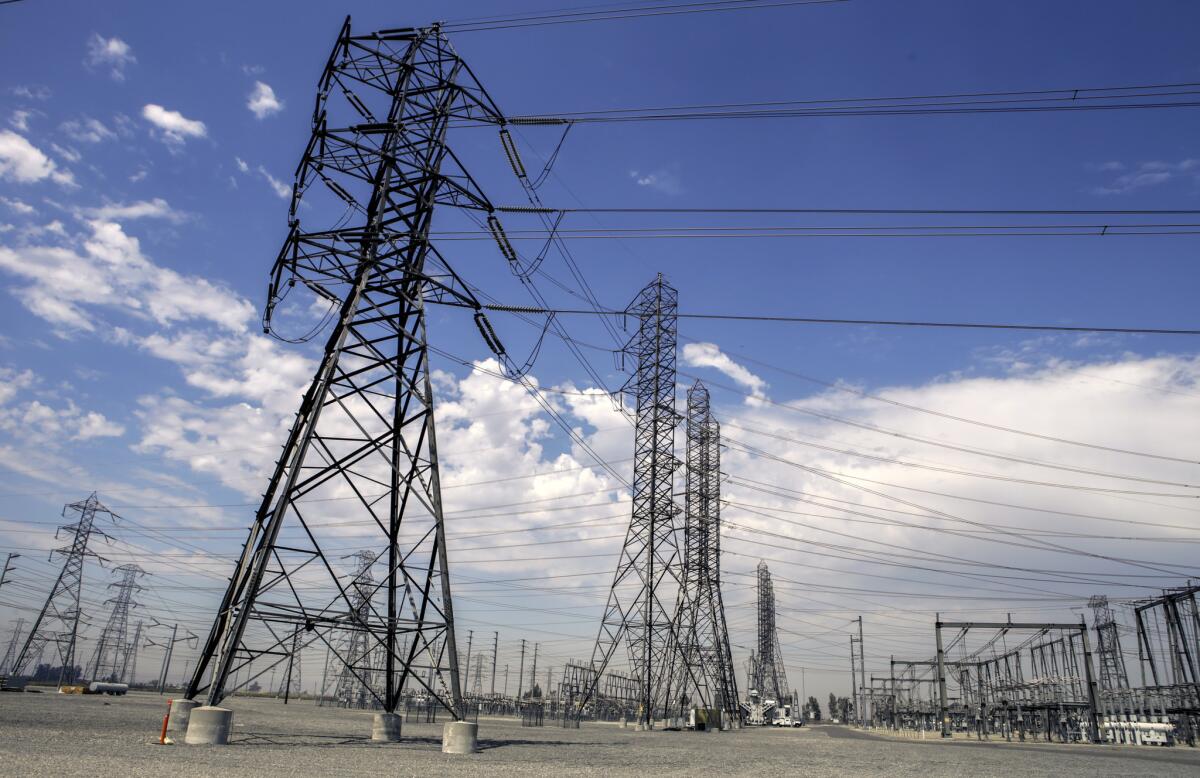Study says expansion of California’s electric grid would save consumers $1.5 billion

- Share via
The manager of the state’s electric grid released studies Tuesday that show its proposed expansion would yield annual consumer savings of as much as $1.5 billion by 2030 and help with the state’s goal of 50% renewable energy by then.
The California Independent System Operator, which produced the nearly 700 pages of reports under a mandate by state lawmakers, said expanding its operations to include more Western states would result in a more efficient electric grid system.
“The studies’ conclusions mirror the preliminary results showing the benefits of expanding the ISO market, advantages we predict will only grow over time,” said Steve Berberich, Cal-ISO’s chief executive. “We believe the findings in these studies will help drive the formation of a new, more efficient, cost-effective and greener Western electric grid.”
Some critics of the electric grid expansion, such as the Sierra Club, question Cal-ISO’s plan. In particular, the critics oppose a Cal-ISO strategy that would add the coal-heavy utility PacifiCorp., a subsidiary of billionaire investor Warren Buffett’s Berkshire Hathaway Energy.
“Linking California’s energy market with coal-heavy PacifiCorp. will increase coal pollution and could extend the lifespan of PacifiCorp.’s old and dirty coal plants for years to come,” said Kathryn Phillips, director of Sierra Club California. “Jamming through legislation on the regionalization proposal without clear rules to prevent more coal pollution would be a huge mistake that can’t be corrected later.”
Others argue that the state should focus on more localized electricity distribution such as rooftop solar and battery storage rather than increasing the size of centralized power.
Jamie Court of Consumer Watchdog said he was surprised that the study did not include any review of what could go wrong -- such as when deregulation adopted by lawmakers in the 1990s led to widespread price manipulation and huge increases in power bills.
“It feels like we’re in a flashback to 2000 and 2001,” Court said. “All the same forces are at work getting us to roll the dice in order to pump up investor profits and take it from ratepayers’ wallets.”
Utility critic Michael Aguirre, a former assistant U.S. attorney and a San Diego lawyer, said Cal-ISO’s conclusions were the result of “a made-to-order report, not a study.”
Cal-ISO spent $2 million through March 31 on more than 30 researchers, economists and energy consultants to review the grid expansion. Several of the firms that produced the study also work for utilities.
Under Cal-ISO’s proposal, PacifiCorp. would become a full participant in California’s electricity market, joining Southern California Edison, Pacific Gas & Electric and San Diego Gas & Electric.
That would extend Cal-ISO’s role as a manager of electricity beyond just California’s borders into other states, including Oregon, Washington, Wyoming, Utah and Idaho.
The new regional system operator would determine when power plants at the various utilities would operate to ensure that the electric grid remains in balance. That is crucial because if too much electricity overloads the system, it can result in blackouts just as surely as when too few electrons are on the power grid.
Cal-ISO and PacifiCorp. promise lower electric rates from the deal. Even more notably, they say, it would make it easier to manage all of the new clean energy that would need to be developed to meet California’s 50% mandate.
See the most-read stories this hour >>
Market simulations conducted by the researchers demonstrated that a regional market would reduce California’s carbon dioxide emissions in 2030 by 4 million to 5 million metric tons, or 8% to 10% of the state’s total electricity sector emissions.
The studies say the expanded grid would help with the creation of 9,900 to 19,400 new jobs in the state as a result of lower energy rates and a slight increase in the state’s household income of $300 to $550 on average by 2030.
Many questions remain about how the new regional operation would work.
There is no explanation for who would be in charge of the regional entity. Right now, the governor appoints members of the Cal-ISO board. Under a draft proposal released by the system operator last month, the regional grid would be governed by a board of utility executives and other energy industry leaders – not elected officials.
A change in the governance structure would require action by state lawmakers.
Grid operators also have yet to formalize transmission charges across the network.
Follow me at @ivanlpenn
ALSO
Feds ask Tesla for Autopilot data in investigation of fatal crash
‘Pokemon Go’ shows augmented reality’s edge over full-on virtual reality
Relax, you’re not going to jail for sharing your Netflix password
UPDATES:
10:47 a.m.: This article was updated with additional comments.
4:42 p.m.: This article was update with new information and comments.
This article was originally published at 10:20 a.m.
More to Read
Inside the business of entertainment
The Wide Shot brings you news, analysis and insights on everything from streaming wars to production — and what it all means for the future.
You may occasionally receive promotional content from the Los Angeles Times.











